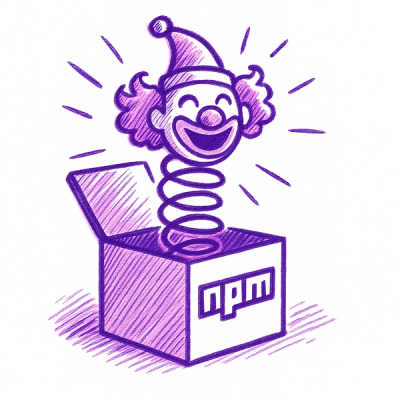
Security News
Open Source Maintainers Feeling the Weight of the EU’s Cyber Resilience Act
The EU Cyber Resilience Act is prompting compliance requests that open source maintainers may not be obligated or equipped to handle.
jsonc-parser
Advanced tools
The jsonc-parser npm package is used for parsing and manipulating JSONC (JSON with Comments) files. It provides functionality to parse JSONC content, extract errors, and visit nodes within the JSONC structure. It also allows for modifications and formatting of the JSONC content.
Parsing JSONC
This feature allows you to parse JSONC content, which includes comments, without stripping them out. It can handle both single-line and multi-line comments.
{"text": "// This is a comment\n{\"key\": \"value\"}"}Extracting Errors
jsonc-parser can extract errors from JSONC content, which is useful for validating and providing feedback on the correctness of the JSONC.
{"text": "{\"key\": \"value\", // invalid comment\n}"}Visiting Nodes
This feature allows you to visit nodes within the JSONC structure and perform operations or analysis on them, such as logging property names.
{"text": "{\"key\": {\"nestedKey\": \"nestedValue\"}}", "visitor": {"onObjectProperty": (property, visitContext) => { console.log(property); }}}Modifying JSONC
jsonc-parser provides functionality to modify the JSONC content by specifying the path to the node and the new value.
{"text": "{\"key\": \"value\"}", "modifications": [{"path": [\"key\"], "value": \"newValue\"}]}Formatting JSONC
This feature allows you to format JSONC content according to specified formatting options, such as using spaces or tabs for indentation.
{"text": "{\"key\":\"value\"}", "options": {"insertSpaces": true, "tabSize": 2}}This package is used to strip comments from JSON or JSONC content, allowing you to parse it with standard JSON parsers. It differs from jsonc-parser as it does not retain comments and does not provide functionality for visiting nodes or extracting errors.
comment-json is similar to jsonc-parser in that it allows for parsing and stringifying JSONC. However, its API and feature set may differ, and it may not have the same focus on providing detailed error information or node visiting capabilities.
Scanner and parser for JSON with comments.
JSONC is JSON with JavaScript style comments. This node module provides a scanner and fault tolerant parser that can process JSONC but is also useful for standard JSON.
npm install --save jsonc-parser
/**
* Creates a JSON scanner on the given text.
* If ignoreTrivia is set, whitespaces or comments are ignored.
*/
export function createScanner(text: string, ignoreTrivia: boolean = false): JSONScanner;
/**
* The scanner object, representing a JSON scanner at a position in the input string.
*/
export interface JSONScanner {
/**
* Sets the scan position to a new offset. A call to 'scan' is needed to get the first token.
*/
setPosition(pos: number): any;
/**
* Read the next token. Returns the token code.
*/
scan(): SyntaxKind;
/**
* Returns the zero-based current scan position, which is after the last read token.
*/
getPosition(): number;
/**
* Returns the last read token.
*/
getToken(): SyntaxKind;
/**
* Returns the last read token value. The value for strings is the decoded string content. For numbers it's of type number, for boolean it's true or false.
*/
getTokenValue(): string;
/**
* The zero-based start offset of the last read token.
*/
getTokenOffset(): number;
/**
* The length of the last read token.
*/
getTokenLength(): number;
/**
* The zero-based start line number of the last read token.
*/
getTokenStartLine(): number;
/**
* The zero-based start character (column) of the last read token.
*/
getTokenStartCharacter(): number;
/**
* An error code of the last scan.
*/
getTokenError(): ScanError;
}
export interface ParseOptions {
disallowComments?: boolean;
allowTrailingComma?: boolean;
allowEmptyContent?: boolean;
}
/**
* Parses the given text and returns the object the JSON content represents. On invalid input, the parser tries to be as fault tolerant as possible, but still return a result.
* Therefore always check the errors list to find out if the input was valid.
*/
export declare function parse(text: string, errors?: {error: ParseErrorCode;}[], options?: ParseOptions): any;
/**
* Parses the given text and invokes the visitor functions for each object, array and literal reached.
*/
export declare function visit(text: string, visitor: JSONVisitor, options?: ParseOptions): any;
/**
* Visitor called by {@linkcode visit} when parsing JSON.
*
* The visitor functions have the following common parameters:
* - `offset`: Global offset within the JSON document, starting at 0
* - `startLine`: Line number, starting at 0
* - `startCharacter`: Start character (column) within the current line, starting at 0
*
* Additionally some functions have a `pathSupplier` parameter which can be used to obtain the
* current `JSONPath` within the document.
*/
export interface JSONVisitor {
/**
* Invoked when an open brace is encountered and an object is started. The offset and length represent the location of the open brace.
* When `false` is returned, the array items will not be visited.
*/
onObjectBegin?: (offset: number, length: number, startLine: number, startCharacter: number, pathSupplier: () => JSONPath) => void | boolean;
/**
* Invoked when a property is encountered. The offset and length represent the location of the property name.
* The `JSONPath` created by the `pathSupplier` refers to the enclosing JSON object, it does not include the
* property name yet.
*/
onObjectProperty?: (property: string, offset: number, length: number, startLine: number, startCharacter: number, pathSupplier: () => JSONPath) => void;
/**
* Invoked when a closing brace is encountered and an object is completed. The offset and length represent the location of the closing brace.
*/
onObjectEnd?: (offset: number, length: number, startLine: number, startCharacter: number) => void;
/**
* Invoked when an open bracket is encountered. The offset and length represent the location of the open bracket.
* When `false` is returned, the array items will not be visited.*
*/
onArrayBegin?: (offset: number, length: number, startLine: number, startCharacter: number, pathSupplier: () => JSONPath) => void | boolean;
/**
* Invoked when a closing bracket is encountered. The offset and length represent the location of the closing bracket.
*/
onArrayEnd?: (offset: number, length: number, startLine: number, startCharacter: number) => void;
/**
* Invoked when a literal value is encountered. The offset and length represent the location of the literal value.
*/
onLiteralValue?: (value: any, offset: number, length: number, startLine: number, startCharacter: number, pathSupplier: () => JSONPath) => void;
/**
* Invoked when a comma or colon separator is encountered. The offset and length represent the location of the separator.
*/
onSeparator?: (character: string, offset: number, length: number, startLine: number, startCharacter: number) => void;
/**
* When comments are allowed, invoked when a line or block comment is encountered. The offset and length represent the location of the comment.
*/
onComment?: (offset: number, length: number, startLine: number, startCharacter: number) => void;
/**
* Invoked on an error.
*/
onError?: (error: ParseErrorCode, offset: number, length: number, startLine: number, startCharacter: number) => void;
}
/**
* Parses the given text and returns a tree representation the JSON content. On invalid input, the parser tries to be as fault tolerant as possible, but still return a result.
*/
export declare function parseTree(text: string, errors?: ParseError[], options?: ParseOptions): Node | undefined;
export declare type NodeType = "object" | "array" | "property" | "string" | "number" | "boolean" | "null";
export interface Node {
type: NodeType;
value?: any;
offset: number;
length: number;
colonOffset?: number;
parent?: Node;
children?: Node[];
}
/**
* Takes JSON with JavaScript-style comments and remove
* them. Optionally replaces every none-newline character
* of comments with a replaceCharacter
*/
export declare function stripComments(text: string, replaceCh?: string): string;
/**
* For a given offset, evaluate the location in the JSON document. Each segment in the location path is either a property name or an array index.
*/
export declare function getLocation(text: string, position: number): Location;
/**
* A {@linkcode JSONPath} segment. Either a string representing an object property name
* or a number (starting at 0) for array indices.
*/
export declare type Segment = string | number;
export declare type JSONPath = Segment[];
export interface Location {
/**
* The previous property key or literal value (string, number, boolean or null) or undefined.
*/
previousNode?: Node;
/**
* The path describing the location in the JSON document. The path consists of a sequence strings
* representing an object property or numbers for array indices.
*/
path: JSONPath;
/**
* Matches the locations path against a pattern consisting of strings (for properties) and numbers (for array indices).
* '*' will match a single segment, of any property name or index.
* '**' will match a sequence of segments or no segment, of any property name or index.
*/
matches: (patterns: JSONPath) => boolean;
/**
* If set, the location's offset is at a property key.
*/
isAtPropertyKey: boolean;
}
/**
* Finds the node at the given path in a JSON DOM.
*/
export function findNodeAtLocation(root: Node, path: JSONPath): Node | undefined;
/**
* Finds the most inner node at the given offset. If includeRightBound is set, also finds nodes that end at the given offset.
*/
export function findNodeAtOffset(root: Node, offset: number, includeRightBound?: boolean) : Node | undefined;
/**
* Gets the JSON path of the given JSON DOM node
*/
export function getNodePath(node: Node): JSONPath;
/**
* Evaluates the JavaScript object of the given JSON DOM node
*/
export function getNodeValue(node: Node): any;
/**
* Computes the edit operations needed to format a JSON document.
*
* @param documentText The input text
* @param range The range to format or `undefined` to format the full content
* @param options The formatting options
* @returns The edit operations describing the formatting changes to the original document following the format described in {@linkcode EditResult}.
* To apply the edit operations to the input, use {@linkcode applyEdits}.
*/
export function format(documentText: string, range: Range, options: FormattingOptions): EditResult;
/**
* Computes the edit operations needed to modify a value in the JSON document.
*
* @param documentText The input text
* @param path The path of the value to change. The path represents either to the document root, a property or an array item.
* If the path points to an non-existing property or item, it will be created.
* @param value The new value for the specified property or item. If the value is undefined,
* the property or item will be removed.
* @param options Options
* @returns The edit operations describing the changes to the original document, following the format described in {@linkcode EditResult}.
* To apply the edit operations to the input, use {@linkcode applyEdits}.
*/
export function modify(text: string, path: JSONPath, value: any, options: ModificationOptions): EditResult;
/**
* Applies edits to an input string.
* @param text The input text
* @param edits Edit operations following the format described in {@linkcode EditResult}.
* @returns The text with the applied edits.
* @throws An error if the edit operations are not well-formed as described in {@linkcode EditResult}.
*/
export function applyEdits(text: string, edits: EditResult): string;
/**
* An edit result describes a textual edit operation. It is the result of a {@linkcode format} and {@linkcode modify} operation.
* It consist of one or more edits describing insertions, replacements or removals of text segments.
* * The offsets of the edits refer to the original state of the document.
* * No two edits change or remove the same range of text in the original document.
* * Multiple edits can have the same offset if they are multiple inserts, or an insert followed by a remove or replace.
* * The order in the array defines which edit is applied first.
* To apply an edit result use {@linkcode applyEdits}.
* In general multiple EditResults must not be concatenated because they might impact each other, producing incorrect or malformed JSON data.
*/
export type EditResult = Edit[];
/**
* Represents a text modification
*/
export interface Edit {
/**
* The start offset of the modification.
*/
offset: number;
/**
* The length of the modification. Must not be negative. Empty length represents an *insert*.
*/
length: number;
/**
* The new content. Empty content represents a *remove*.
*/
content: string;
}
/**
* A text range in the document
*/
export interface Range {
/**
* The start offset of the range.
*/
offset: number;
/**
* The length of the range. Must not be negative.
*/
length: number;
}
/**
* Options used by {@linkcode format} when computing the formatting edit operations
*/
export interface FormattingOptions {
/**
* If indentation is based on spaces (`insertSpaces` = true), then what is the number of spaces that make an indent?
*/
tabSize: number;
/**
* Is indentation based on spaces?
*/
insertSpaces: boolean;
/**
* The default 'end of line' character
*/
eol: string;
}
/**
* Options used by {@linkcode modify} when computing the modification edit operations
*/
export interface ModificationOptions {
/**
* Formatting options. If undefined, the newly inserted code will be inserted unformatted.
*/
formattingOptions?: FormattingOptions;
/**
* Default false. If `JSONPath` refers to an index of an array and `isArrayInsertion` is `true`, then
* {@linkcode modify} will insert a new item at that location instead of overwriting its contents.
*/
isArrayInsertion?: boolean;
/**
* Optional function to define the insertion index given an existing list of properties.
*/
getInsertionIndex?: (properties: string[]) => number;
}
(MIT License)
Copyright 2018, Microsoft
FAQs
Scanner and parser for JSON with comments.
The npm package jsonc-parser receives a total of 19,721,597 weekly downloads. As such, jsonc-parser popularity was classified as popular.
We found that jsonc-parser demonstrated a not healthy version release cadence and project activity because the last version was released a year ago. It has 0 open source maintainers collaborating on the project.
Did you know?

Socket for GitHub automatically highlights issues in each pull request and monitors the health of all your open source dependencies. Discover the contents of your packages and block harmful activity before you install or update your dependencies.

Security News
The EU Cyber Resilience Act is prompting compliance requests that open source maintainers may not be obligated or equipped to handle.

Security News
Crates.io adds Trusted Publishing support, enabling secure GitHub Actions-based crate releases without long-lived API tokens.

Research
/Security News
Undocumented protestware found in 28 npm packages disrupts UI for Russian-language users visiting Russian and Belarusian domains.